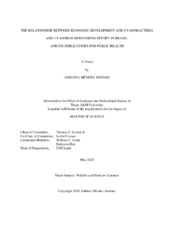| dc.description.abstract | Cyanobacterial harmful algal blooms (cyanoHABs) are a public health risk because cyanobacteria produce cyanotoxins that affect humans. CyanoHABs have increased globally, causing human intoxications and fatalities. Since cyanoHABs are recurrent, people are constantly exposed to cyanotoxins, through drinking water, food ingestion, aquatic activities, or hemodialysis.
Despite increased cyanoHAB global awareness, little is known about cyanobacteria diversity and distribution in South America. In addition, non-biological variables inducing differential exposure to cyanotoxins have not been addressed. The objective of this study is to assess the relation between economic development and cyanoHAB monitoring effort and the impact of cyanoHABs human exposure to cyanotoxins in Brazil.
I reviewed the occurrence of cyanoHABs in South America with an emphasis on Brazil and analyzed the relationship between gross domestic product per capita (GDPPC) and monitoring effort. The most common cyanobacterial genera in South America were Microcystis, Anabaena, Dolichospermum and Planktothrix, all cyanoHAB and cyanotoxin producers.
The most common cyanotoxins for the region were microcystins (MCs) and saxitoxins (STXs). Both have severe adverse health effects in humans and have caused fatalities.
Microcystis aeruginosa and Cylindrospermopsis raciborskii were the most commonly identified species, and both produce several cyanotoxins. Therefore, it is likely that their toxins are present in water reservoirs across the region, severely compromising the quality of drinking water. Furthermore, most publications reported mixtures of two or more cyanotoxins, thus resulting in greater additive or synergistic toxicity than what would be expected from a single cyanotoxin.
GDPPC and monitoring effort were strongly correlated, when monitoring effort was defined as number of municipalities sampled, national percentage of municipalities sampled, and number of monitoring events. Brazilian regions with the lowest GDPPC (i.e. Central-west, North, and Northeast), were monitored significantly less than regions with the highest GDDPC (i.e. South and Southeast). This coincided with Brazil’s historic North-Northeast/South-Southeast income gradient. Although Brazil has a cyanoHAB monitoring program, only 2.8% of Brazil’s municipalities were monitored at least once a month, and merely 0.1% were monitored monthly. Unfortunately, the data gathered are not biologically informative because cyanobacterial densities, cyanotoxin types, and cyanotoxin concentrations are not recorded. Significant enhancements in the frequency and quality of monitoring efforts need to be implemented to improve public health outcomes. | en |


